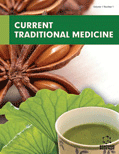Abstract
Kalanchoe thyrsiflora Harv. (Crassulaceae) is a medicinal plant traditionally used in South Africa. As previously shown, the methanolic extracts from leaves and roots of K. thyrsiflora have antitumor activity against some cell lines. This study aimed to investigate the phenolic constituents of K. thyrsiflora leaves with the goal of detecting potential new treatments for acute lymphocytic leukemia (ALL), the most frequent type of cancer in children. The phenolic compounds isorhamnetin 3-O-β- glucopyranoside (1), astragalin (2), isoquercitrin (3), gallic acid (4), isorhamnetin (5) and kaempferol (6) were identified in the ethyl acetate fraction, based on 1H and 13C NMR data. The phenolic profile of the leaf extract was analyzed by HPLC-DAD. Our findings indicated that the enriched polyphenolic fraction has important cytotoxicity against lymphocytic leukemia cells, with gallic acid mainly contributing to this effect. The ethyl acetate fraction also inhibited leukemia cell proliferation and induced them into apoptosis, but without toxicity to mononuclear cells of healthy humans. This is the first report on the phenolic profile of K. thyrsiflora species and its antileukemia potential.
Keywords: Apoptosis, Cytotoxicity, Gallic acid, Jurkat cells, Kalanchoe thyrsiflora, Leukemia.
Current Traditional Medicine
Title:Gallic Acid as the Main in vitro Antileukemia Compound from Kalanchoe thyrsiflora Leaf Extract
Volume: 1 Issue: 3
Author(s): Isabel Cristina Vieira da Silva, Livia Marques Casanova, Gleison Magalhães Freitas, Thiago Martino, Monica Farah Pereira, Fernanda Helena Pereira dos Santos, Katia Costa de Carvalho Sabino and Sônia Soares Costa
Affiliation:
Keywords: Apoptosis, Cytotoxicity, Gallic acid, Jurkat cells, Kalanchoe thyrsiflora, Leukemia.
Abstract: Kalanchoe thyrsiflora Harv. (Crassulaceae) is a medicinal plant traditionally used in South Africa. As previously shown, the methanolic extracts from leaves and roots of K. thyrsiflora have antitumor activity against some cell lines. This study aimed to investigate the phenolic constituents of K. thyrsiflora leaves with the goal of detecting potential new treatments for acute lymphocytic leukemia (ALL), the most frequent type of cancer in children. The phenolic compounds isorhamnetin 3-O-β- glucopyranoside (1), astragalin (2), isoquercitrin (3), gallic acid (4), isorhamnetin (5) and kaempferol (6) were identified in the ethyl acetate fraction, based on 1H and 13C NMR data. The phenolic profile of the leaf extract was analyzed by HPLC-DAD. Our findings indicated that the enriched polyphenolic fraction has important cytotoxicity against lymphocytic leukemia cells, with gallic acid mainly contributing to this effect. The ethyl acetate fraction also inhibited leukemia cell proliferation and induced them into apoptosis, but without toxicity to mononuclear cells of healthy humans. This is the first report on the phenolic profile of K. thyrsiflora species and its antileukemia potential.
Export Options
About this article
Cite this article as:
Vieira da Silva Cristina Isabel, Casanova Marques Livia, Freitas Magalhães Gleison, Martino Thiago, Pereira Farah Monica, Pereira dos Santos Helena Fernanda, de Carvalho Sabino Costa Katia and Costa Soares Sônia, Gallic Acid as the Main in vitro Antileukemia Compound from Kalanchoe thyrsiflora Leaf Extract, Current Traditional Medicine 2015; 1 (3) . https://dx.doi.org/10.2174/221508380103151231152219
| DOI https://dx.doi.org/10.2174/221508380103151231152219 |
Print ISSN 2215-0838 |
| Publisher Name Bentham Science Publisher |
Online ISSN 2215-0846 |
 20
20
- Author Guidelines
- Bentham Author Support Services (BASS)
- Graphical Abstracts
- Fabricating and Stating False Information
- Research Misconduct
- Post Publication Discussions and Corrections
- Publishing Ethics and Rectitude
- Increase Visibility of Your Article
- Archiving Policies
- Peer Review Workflow
- Order Your Article Before Print
- Promote Your Article
- Manuscript Transfer Facility
- Editorial Policies
- Allegations from Whistleblowers
- Announcements


























